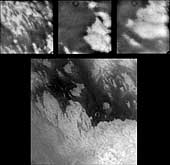|
COMETS EARTH JUPITER KUIPER BELT MARS MERCURY METEORITES NEPTUNE OORT CLOUD PLUTO SATURN SOLAR SYSTEM SPACE SUN URANUS VENUS ORDER PRINTS
PHOTO CATEGORIES SCIENCEVIEWS AMERICAN INDIAN AMPHIBIANS BIRDS BUGS FINE ART FOSSILS THE ISLANDS HISTORICAL PHOTOS MAMMALS OTHER PARKS PLANTS RELIGIOUS REPTILES SCIENCEVIEWS PRINTS
|
Related Documents
Download Options
These images, taken during Cassini's first close flyby of Titan, show details never before seen on Titan's mysterious surface. The large, bottom image shows a complex interplay between dark and bright material on Titan's surface. This image was taken at a range of about 340,000 kilometers (211,000 miles), and the entire view is approximately 2,000 kilometers (1,200 miles) across. The surface appears to have been shaped by multiple geologic processes. Although a few circular features can be seen, there are no features that can be definitively identified as impact craters. Cassini scientists are studying these and other images acquired during the flyby to understand the nature and origins of the intriguing features. The three smaller images show details of some of the features seen within the larger scene. The image on the upper right shows a scene approximately 500 kilometers (311 miles) across in which bright and dark bands of material span east to west. The upper middle and upper right images show bright material surrounded by dark material in scenes approximately 300 kilometers (186 miles) across. Very narrow, dark bands can be seen crossing the bright terrain. These features are approximately 2 kilometers (1.2 mile) across and up to a few hundred kilometers long. The dark circular feature that appears at the top of each of the upper images is a camera artifact that was not removed by the preliminary image processing. The tops of the images point to the northwest. The Sun is illuminating Titan from nearly behind the spacecraft, and there are no shadows or topographic shading visible in these images. All shading is due to surface brightness contrasts. The images were captured by Cassini's imaging science subsystem through near-infrared filters. |
